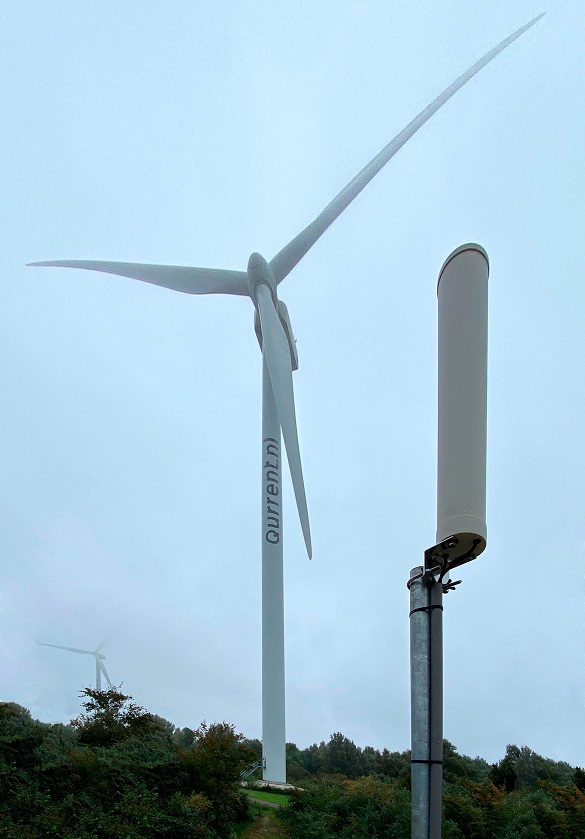Which Antenna for Fast Internet
Which antenna for fast internet
Antennas are our company's secret weapon.
But what is an antenna?
Antennas have been around for a long time and are used for many applications.
On this page, we limit ourselves to antennas that can be used for internet and WiFi. For other applications, we provide you with links to other pages.

What is an antenna?
The general description for antenna is:
An antenna is a device for transmitting and/or receiving electrical waves. An antenna converts a radio frequency field into an alternating current or vice versa.
The coils used by Nikola Tesla around 1890 are considered to be one of the first forms of antennas.
When the generation of radio waves with an ultra-short wavelength became possible in the 1920s, antennas could also be made for one particular frequency only and different antenna types were developed. Nowadays, there are many different types of antennas.
Antennas convert electrical signals into radio waves. These are also called electromagnetic fields or radiation. You cannot see these waves or fields. They are invisible waves travelling through the air.
All antenna installations and devices with an antenna send and receive information via these fields. For example: radio, mobile phone, tablet, baby monitor and Wi-Fi networks. Electromagnetic fields are all around us. The fields or waves have a certain frequency.
Frequency
is the number of vibrations per second of a radio wave.
The unit is hertz.
Mobile communication works on frequencies between 700 megahertz and 2600 megahertz. As of 5G, even higher frequencies can be used, 3500Mhz and also 35,000MHz (35GHz.) Mobile providers choose which generation (G) they deploy on a frequency. This can be 3G, 4G or 5G or a combination.
These sites contain lists of antennas and explain how they work:

Which antenna to transmit -vs- which antenna to receive
For both a transmitting and a receiving antenna, the directional characteristic is an important property.
The directional characteristic shows in which direction a transmitting antenna beams the radiation.
For a receiving antenna, the directional characteristic indicates the sensitivity of the antenna to different directions.
Some receiving antennas are only sensitive in one particular direction, so that only signals from that direction can be received.

What can you use an aerial for?
In this paper we limit ourselves to antennas for mobile telecommunications and the internet, but antennas are also used for:
-radio and TV
-mobile phone and walkie-talkie
-semaphone
-point to point jet connections
-Communication systems for emergency services
Wifi antenna
A WiFi antenna or dish always needs a line-of-sight connection to the WiFi transmitter mast in order to receive a signal.
Every object; tree or pole prevents WiFi from reaching the endpoint.
A WiFi antenna can only reach one mast. If this is not accessible, you have no internet.
=====
Example:
Last year we went on holiday to the beautiful Italian province of Le Marche at Menno and Mireilles www.casacastignano.com.
Their house was on a hilltop. Fantastic surroundings, beautiful house, kind people and delicious food... Highly recommended.
Regarding their internet:
At the bottom of the village of Offida was a central WiFi transmission tower.
Because Menno's house had a clear view of this village (not their own), and thus of the transmitter mast, he was able to achieve an internet speed of about 30/10 with the help of a WiFi dish in good weather.
Had the house been on the other side of the hill, too bad, no internet with this solution.
The AirInternet solution that we had with us (as always :)) easily reached a speed of 60/30, without an antenna,
on both sides of the hill !!!
=====
Which antenna for fast internet does QCS AirInternet use:
Standard
The standard antennas that we use can always see 360 degrees (omni) when freely mounted. A free view is important because it allows you to receive the optimal signal. If you place the antenna against a wall, you limit the view because an antenna cannot see through a wall.
The second benefit is that our standard antenna, provided it has a clear view, has a range of 10 kilometers. Within these 10 kilometers, it can see all radio masts and the modem itself selects the strongest signal. If the signal from one aerial goes down, the modem can independent and automaticassly switch to another aerial within its range.
Challenge - we love a challenge!
If a location is in a more challenging coverage area, we can still work with directional antennas. These do not have a 360-degree view, but look in a radius of, say, 60 degrees. The amplified signal that is created in this 60-degree angle has a much longer range, allowing distances of up to 40 kilometers to be covered. This allows a stable connection to be established in the middle of a coverage area blind spot.
Mobile sites
All of the above are examples of stationary antennas, but of course there are also many examples where one has to deal with a mobile location. Think of the shipping industry, transport sector or buses and campers. For these mobile locations there are several special antennas on the market such as puck antennas and maritime antennas that are specially built to perform optimally in these harsh conditions.
The standard antenna cable is 5 metres and the modem must be placed within these 5 metres. The modem is plugged into a nearby wall socket. Nowadays, however, there are also antennas in which the modem is built in and the whole thing is powered by PoE (power over Ethernet). Modem and antenna are in one waterproof and easy to mount housing.
The big benefit is that instead of 5 meters, you can now work with up to 90 meters without losing signal! This is because the distance between modem and router is increased to 100 yards.
Conclusion:
Whatever the situation, thanks to the wide variety of antennas, a stable and fast connection can be created everywhere in Europe.
For an overview of the antennas we currently deploy, please request our product catalogue at sales@airinternet.eu.

Where can I order this fast internet antenna?
We deliver our products all over Europe. We do this through a partner network.
Contact us and we will look at the possibilities and put you in touch with a supplier.
Ordered today, delivered tomorrow!
Call +31 88 433 33 33 or mail to info@airinternet.eu.
Or would you like to become a partner yourself? Of course you can! Call +31 88 433 33 01 or mail to sales@airinternet.eu for your own partnership!
